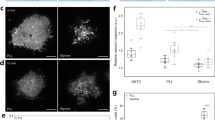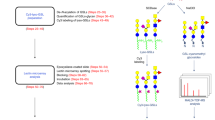Abstract
MORPHOGENESIS and malignant invasion seem to be dependent on cellular migration and changes in cellular adhesiveness1–3. Plant lectins such as concanavalin A (con A) have been extensively used to study the nature and distribution of lectin receptor sites on the surfaces of normal, embryonic and tumour cells. These sites may be involved in controlling cellular migration and adhesiveness2,4,5.
This is a preview of subscription content, access via your institution
Access options
Subscribe to this journal
Receive 51 print issues and online access
$199.00 per year
only $3.90 per issue
Buy this article
- Purchase on Springer Link
- Instant access to full article PDF
Prices may be subject to local taxes which are calculated during checkout
Similar content being viewed by others
References
Townes, P. L., and Holtfreter, J., J. exp. Zool., 128, 53–120 (1955).
Moscona, A. A., Science, 171, 905–907 (1971).
Nicolson, G. L., Winkelhake, J. L., Nature, 255, 230–232 (1975).
Friberg, S. J., Cochran, A. J., and Golub, S. H., Nature new Biol., 232, 121–122 (1971).
Oppenheimer, S. B., Edidin, M., Orr, C. W., and Roseman, S., Proc. natn. Acad. Sci. U.S.A., 63, 1395–1402 (1969).
Kleinschuster, S. J., and Moscona, A. A., Expl Cell Res., 70, 397–410 (1972).
Krach, S. W., Green, A., Nicolson, G. L., and Oppenheimer, S. B., Expl Cell Res., 84, 191–198 (1974).
Sivak, A., and Wolman, S. R., In Vitro, 8, 1–6 (1972).
Robertson, M., and Oppenheimer, S. B., Expl Cell Res., 91, 263–268 (1975).
Roberson, M., Neri, A., and Oppenheimer, S. B., Science (in the press).
Noonan, K. D., and Burger, M. M., J. Cell Biol., 59, 134 (1973).
Nicolson, G. L., Concanavalin A (edit. by Chowdhury, T. K., and Weiss, A. K.), 153–172 (1975).
Rosenblith, J. Z., Ukena, T. E., Yin, H., Berlin, R. D., and Karnovsky, M. J., Proc. natn. Acad. Sci. U.S.A., 70, 1625–1629 (1973).
Nicolson, G. L., and Yanagimachi, R., Science, 184, 1294–1296 (1974).
Inbar, M., Huet, C., Oseroff, A. R., Ben-Bassat, H., and Sachs, L., Biochim. biophys. Acta, 311, 594–599 (1973).
Levin, A., Killander, D., Klein, E., Nordenskjöld, B., and Inoue, M., Ann. N.Y. Acad. Sci., 177, 481–489 (1971).
Neri, A., Roberson, M., Oppenheimer, S. B., in Concanavalin A as a Tool (edit. by Bittiger, H., and Schnebli, H. P.) (in the press).
Author information
Authors and Affiliations
Rights and permissions
About this article
Cite this article
NERI, A., ROBERSON, M., CONNOLLY, D. et al. Quantitative evaluation of concanavalin A receptor site distributions on the surfaces of specific populations of embryonic cells. Nature 258, 342–344 (1975). https://doi.org/10.1038/258342a0
Received:
Accepted:
Issue Date:
DOI: https://doi.org/10.1038/258342a0
This article is cited by
-
Cell-to-substratum adhesion of dissociated embryonic cells of the sea urchin,Pseudocentrotus depressus
Wilhelm Roux's Archives of Developmental Biology (1984)
-
Use of lectins as probes for analyzing embryonic induction
Wilhelm Roux's Archives of Developmental Biology (1981)
-
Changes in the cell surface coat during the development ofXenopus laevis embryos, detected by lectins
Wilhelm Roux's Archives of Developmental Biology (1978)
-
Struktur ? Funktion und analytischer Einsatz in biologischen Systemen
Klinische Wochenschrift (1977)
Comments
By submitting a comment you agree to abide by our Terms and Community Guidelines. If you find something abusive or that does not comply with our terms or guidelines please flag it as inappropriate.



